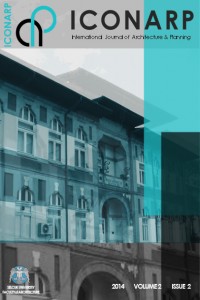Impact of Thermal Mass Oriented Measures Over CO2 Emissions Of a Thermally Insulated Lowrise Apartment Building in Izmir, Turkey
Öz
Climate change has drawn the attention of many researchers and practitioners to focus on the methods to address the challenges in achieving low-carbon buildings and cities and in future developments. Nevertheless, few studies have explored the impacts of thermal mass applications for the lowest carbon emissions of building operational energy consumption. A comparative study of CO2 emissions due to different wall and floor compositions is presented in accordance with their lifespans for a hot-humid climate site. Aim of this study is to examine the relation between the energy oriented operations and carbon emissions of the building. Firstly, an existing low-rise building in İzmir is selected, then modelled in the dynamic simulation model software DesignBuilder v4 by synchronizing drawings with basic operational principles of the program. Furthermore, various influence factors of building envelope thermal characteristics are selected as follows: type, location, thickness and thermal specifications of materials used by keeping thermal conductivity value constant. At the end, the research presents remarkable influence of thermal mass oriented measures on reducing energy demands and carbon footprints.
Anahtar Kelimeler
Kaynakça
- ASHRAE Guideline. (2002). Measurement of Energy and Demand Savings. American Society of Heating, Refrigerating and Air- Conditioning Engineers, Inc., Atlanta.
- Byrne, S., and Ritschard, R. (1985). "A parametric analysis of thermal mass in residential buildings". Proceedings of the ASHRAE/DOE/BTECC Conference on Thermal Performance of the Exterior Envelopes of Buildings: 2-5.
- CIBSE TM 36. (2005). Climate Change and the Indoor Environment of Buildings. Chartered Institution of Building Services Engineers.
- Climate Consultant v.5.4. http://climateconsultant.software.informer.com/5.4/ (date of connection, 2013)
- DesignBuilder v.4. www.designbuilder.co.uk (date of connection, 2013)
- Dombaycı, A. (2013). "Investigation of the Effect of Thermal Insulation for a Model House in Cold Regions: A Case Study of Turkey". Environmental Progress & Sustainable Energy: 527- 537.
- Duzgun, B., and Komurgoz, G. (2014). "Turkey’s energy efŞciency assessment: White CertiŞcates Systems and their applicability in Turkey". Energy Policy: 465-474.
- Fernandez, N. (2008). "The influence of construction materials on life-cycle energy use and carbon dioxide emissions of medium size commercial buildings". MSc. Victoria University of Wellington.
- Gregory, C., Moghtaderi, B., Sugo, H. and Page, A. (2008). "Effect of thermal mass on the thermal performance of various Australian residential constructions systems". Energy and Buildings: 459-65.
- M & V Guidelines. (2008).. Measurement and Verification for Federal Energy Projects, Version 3. U.S. DoE. Federal Energy Management Program. IPMVP: International Performance Verification Protocol-Concepts and Options for Determining Energy and Water Savings V.1. (2001). International Performance Measurement and Verification Committee. and
- Turkish Statistical Institute (TUIK). (2013). Energy Statistics: Annual Import.
- Zeng, R., Wang, X., Di, H., Feng, J. and Yinping, Z. (2011). "New concepts and approach for developing energy efficient buildings: Ideal specific heat for building internal thermal mass". Energy and Buildings: 1081-1090. CV (Resume) Mümine Gerçek
- She was born in 1989 in Bulgaria. She graduated from Middle
- East Technical University Department of Architecture in 2013. She
- started her master program in İzmir Institute of Technology
- Department of Architecture in 2013. She has been working in the same
- department since 2014 as a research assistant on energy efficient buildings.
Öz
Kaynakça
- ASHRAE Guideline. (2002). Measurement of Energy and Demand Savings. American Society of Heating, Refrigerating and Air- Conditioning Engineers, Inc., Atlanta.
- Byrne, S., and Ritschard, R. (1985). "A parametric analysis of thermal mass in residential buildings". Proceedings of the ASHRAE/DOE/BTECC Conference on Thermal Performance of the Exterior Envelopes of Buildings: 2-5.
- CIBSE TM 36. (2005). Climate Change and the Indoor Environment of Buildings. Chartered Institution of Building Services Engineers.
- Climate Consultant v.5.4. http://climateconsultant.software.informer.com/5.4/ (date of connection, 2013)
- DesignBuilder v.4. www.designbuilder.co.uk (date of connection, 2013)
- Dombaycı, A. (2013). "Investigation of the Effect of Thermal Insulation for a Model House in Cold Regions: A Case Study of Turkey". Environmental Progress & Sustainable Energy: 527- 537.
- Duzgun, B., and Komurgoz, G. (2014). "Turkey’s energy efŞciency assessment: White CertiŞcates Systems and their applicability in Turkey". Energy Policy: 465-474.
- Fernandez, N. (2008). "The influence of construction materials on life-cycle energy use and carbon dioxide emissions of medium size commercial buildings". MSc. Victoria University of Wellington.
- Gregory, C., Moghtaderi, B., Sugo, H. and Page, A. (2008). "Effect of thermal mass on the thermal performance of various Australian residential constructions systems". Energy and Buildings: 459-65.
- M & V Guidelines. (2008).. Measurement and Verification for Federal Energy Projects, Version 3. U.S. DoE. Federal Energy Management Program. IPMVP: International Performance Verification Protocol-Concepts and Options for Determining Energy and Water Savings V.1. (2001). International Performance Measurement and Verification Committee. and
- Turkish Statistical Institute (TUIK). (2013). Energy Statistics: Annual Import.
- Zeng, R., Wang, X., Di, H., Feng, J. and Yinping, Z. (2011). "New concepts and approach for developing energy efficient buildings: Ideal specific heat for building internal thermal mass". Energy and Buildings: 1081-1090. CV (Resume) Mümine Gerçek
- She was born in 1989 in Bulgaria. She graduated from Middle
- East Technical University Department of Architecture in 2013. She
- started her master program in İzmir Institute of Technology
- Department of Architecture in 2013. She has been working in the same
- department since 2014 as a research assistant on energy efficient buildings.
Ayrıntılar
| Birincil Dil | İngilizce |
|---|---|
| Bölüm | Makaleler |
| Yazarlar | |
| Yayımlanma Tarihi | 23 Nisan 2015 |
| Yayımlandığı Sayı | Yıl 2014 Cilt: 2 Sayı: 2 |


